Recreating the Country blog |
|
Silver Wattle, Acacia dealbata 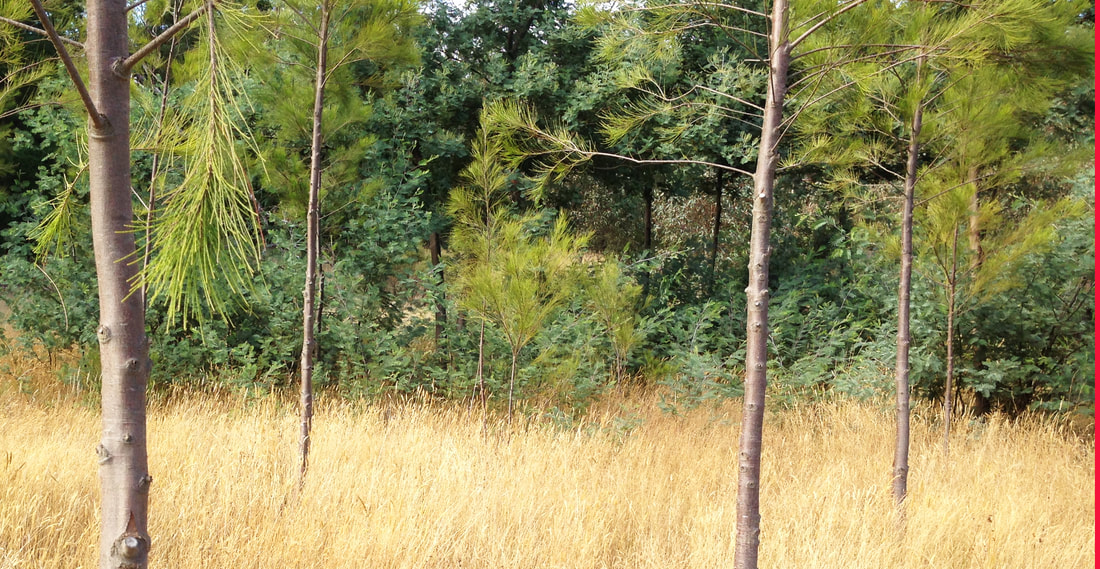 The grey leaves of the Silver Wattle suckering beyond the grass. The trunks of form pruned River Sheoaks in the foreground at the Biorich demonstration site near Lal Lal The grey leaves of the Silver Wattle suckering beyond the grass. The trunks of form pruned River Sheoaks in the foreground at the Biorich demonstration site near Lal Lal A tree or a thicket In the early days of the nursery when we were exploring the district, we came across a great swimming hole on the Yarrowee River near Mt Mercer. On the steep walk down to the river bank I noticed a young Silver Wattle growing on the side of the track. When we returned each year to collect seed, the single stem had multiplied until ten years later it was a dense thicket. It had become popular haunt for Grey Fantails, Superb Fairy Wrens and Willie Wagtails. I discovered that the fifty or so stems of this copse all shared the one root system. They were suckers of the original tree that had grown from a single seed a decade before. This observation supported by research became very useful knowledge in later years. When a customer asked for suitable a tree to bind an eroding gully or river bank, my confident recommendation was Silver Wattle planted with a ground layer of Silver Tussock Grass. Both species named silver for their silver foliage and both gold class for their effectiveness at controlling erosion. Note. Its suckering habit and size make it unsuitable for small gardens. 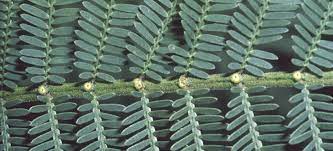 The regularly spaced doughnut shaped glands on a leaf of the Silver Wattle The regularly spaced doughnut shaped glands on a leaf of the Silver Wattle Commonly pronounced – deal-ba-ta Dealbatus is Latin for whitened. A white powder on the leaves and stems gives the tree a silvery appearance. This can vary from location to location and season to season. So much so that sometimes distinguishing Silver Wattle from Black Wattle, A. mearnsii can be difficult. This is easily sorted by examining the pattern of glands on the central rib or rachis of the leaf (the glands resemble tiny green doughnuts); To quote Leon Costermans, ‘Native trees and shrubs of south-eastern Australia’, A. mearnsii – glands are numerous, hairy and irregularly spaced along the length of the minutely velvety rachis A. dealbata – glands are at the base of each pair of pinnae (the rows of leaflets extending out from the central rachis The Australian Native plants Society has a more detailed but concise description of Silver Wattle. Also the SA Botanical Gardens website has some great photos. (Click on the front page circular image to see more photos). 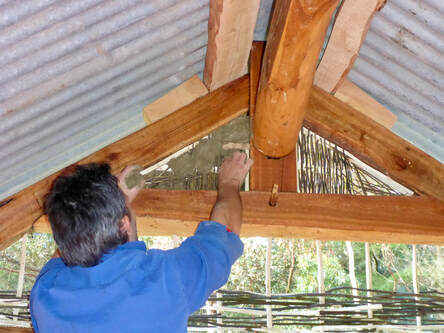 Lachie Parks filling in the wattle & daub in the 'drop slab hut' at ImLal near Lal Lal. Silver Wattle suckers provided the structure for the mud render to adhere to. Photo Gib Wettenhall. Click on the image to read about this unique project Lachie Parks filling in the wattle & daub in the 'drop slab hut' at ImLal near Lal Lal. Silver Wattle suckers provided the structure for the mud render to adhere to. Photo Gib Wettenhall. Click on the image to read about this unique project Practical uses Silver Wattle is indigenous to New South Wales, Victoria and Tasmania and naturalised in South Australia and Western Australia. It grows to a height of 8-12 metres. They are typically found along the edge of waterways and are well adapted to short periods of flooding. It therefore grows quite well in poorly drained soils, though its normal lifespan of around 20 + years is often reduced by as much as 50%. Like the Black Wattle, it is fast growing and produces an excellent hot burning firewood. If grown for firewood it would be ideal to choose a non-suckering provenance. These are more likely to be found in the higher rainfall districts. The honey coloured timber is useful for bespoke furniture and interior lining boards, but its uses are mainly limited craft furniture and turning. The oil extract or essence from the Silver Wattle flowers is in demand and a popular ingredient of perfumes. (It is known to contain enanthic (heptanoic) acid, palmic aldehyde, anisic acid, acetic acid, and phenols) A marketing description on an essence bottle sums up its potential. ‘Wonderfully rich, honey sweet, floral woody aroma which is uplifting, relaxing, calming, anti-depressive, aids happiness and calms noisy children. It sounds like the perfect antidote to modern living The bright yellow pompom flowers and tip shoots are harvested for use as cut flowers, known in the florist trade as "mimosa. The flowers are also a good source of protein rich pollen for bees, yielding an average of 21.4% crude protein. The peak flowering months are September and October The aromatic pollen rich flowers can also be used in fritters. The gum or kino collected from the trunk is edible and is used as a substitute for Gum Arabic. 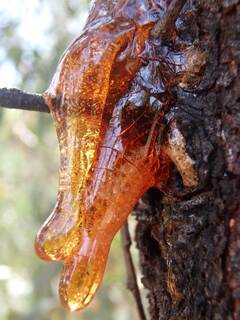 Wattle gum. Photo Barb Dobson Wattle gum. Photo Barb Dobson Traditional Owner uses Tools Silver Wattle’s suckering habit produces long straight strong stems which were ideal for making spears. Boomerangs, spear throwers, clubs, shields, handles for axes and chisels, coolamons, digging sticks, clap sticks and fire drills could also be made from its very hard wood. Silver wattle wood was also used to make handles for stone axes. The bark was used for implements and dishes. Ref: Victorian Koorie Plants by Beth Gott and John Conran Gums Both Black Wattle and Silver Wattle were important sources of gum. To ensure good flow of gum indigenous people notched the trunk in autumn. Balls of gum were then collected and eaten as a snack or dissolved in water with aromatic nectar collected from the flowers to make sweet drinks and Jelly. Heating makes it soft and chewable. Pale coloured gums are more likely to be sweet and pleasant to chew. The dark gum is rich in tannins and is more astringent. When the gum is mixed with burnt mussel shells or wood ash it becomes a cement for water buckets made from the bark of the tree. The bark also provided fibre to make a coarse string and was infused in hot water as a remedy for indigestion. 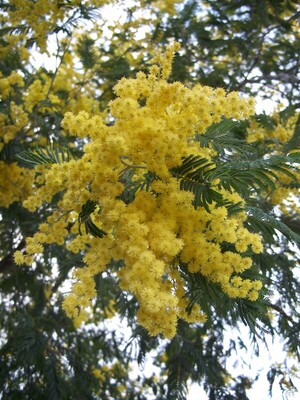 The bright yellow flowers of the Silver Wattle The bright yellow flowers of the Silver Wattle Nature notes The Silver Wattles has bright yellow flowers (varying from lemon to golden) in early spring (July – October). This makes a stunning display against its grey-green ‘ferny’ leaves. All wattles fix atmospheric nitrogen in the soil. This benefits neighbouring plants particularly in leached and low nutrient soils. Choose drought tolerant understorey plants Survival for other plants growing near mature Silver Wattles can become a struggle. The roots of the Silver Wattle tenaciously suck-out all the available soil moisture around the tree, particularity in dry seasons. This eventually can become a bare zone where only the toughest shade tolerant native shrubs, grasses and lilies will grow. Its suckering habit makes this dry zone spread and reducing available light Silver Wattle in biorich design In 50+ meter wide sustainable biodiversity (biorich) plantings, Silver Wattles are planted in small clumps of 5-10 trees/clump. These clumps numbers can be increased to 50 if the wattles are grown to harvest for poles, lining boards or tan bark. This clump planting provides a concentrated source of food for wildlife and results in excellent pollination and seed production. It also makes it convenient to thin or harvest firewood. ‘Natural Selection’ will determine the strongest and fittest trees for the plantation as it matures. 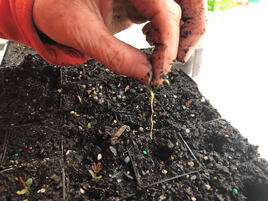 Planting wattle seedlings into tubes. Planting wattle seedlings into tubes. Propagating from seed As with other wattles the trick to germinating Silver Wattle seed is to soften or scratch (scarify) the hard seed coat. Softening is conveniently done by pouring recently boiled water over the seed. Allow this to cool, pour off the excess water then sow into a well-drained seed raising mix. Cover the seed. After the boiled water treatment the seeds can be patted dry for direct seeding into a plantation. The seedlings are transplanted when they lift their heads above the seed bed. This is my preferred method because it is fast and causes no damage to the root system which at this early stage is just a single shoot.
0 Comments
Leave a Reply. |
Click on the image below to discover 'Recreating the Country' the book.
Stephen Murphy is an author, an ecologist and a nurseryman. He has been a designer of natural landscapes for over 30 years. He loves the bush, supports Landcare and is a volunteer helping to conserve local reserves.
He continues to write about ecology, natural history and sustainable biorich landscape design. 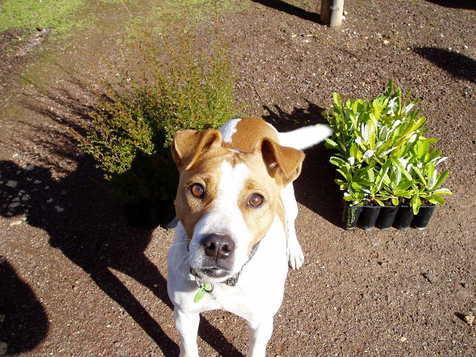
|
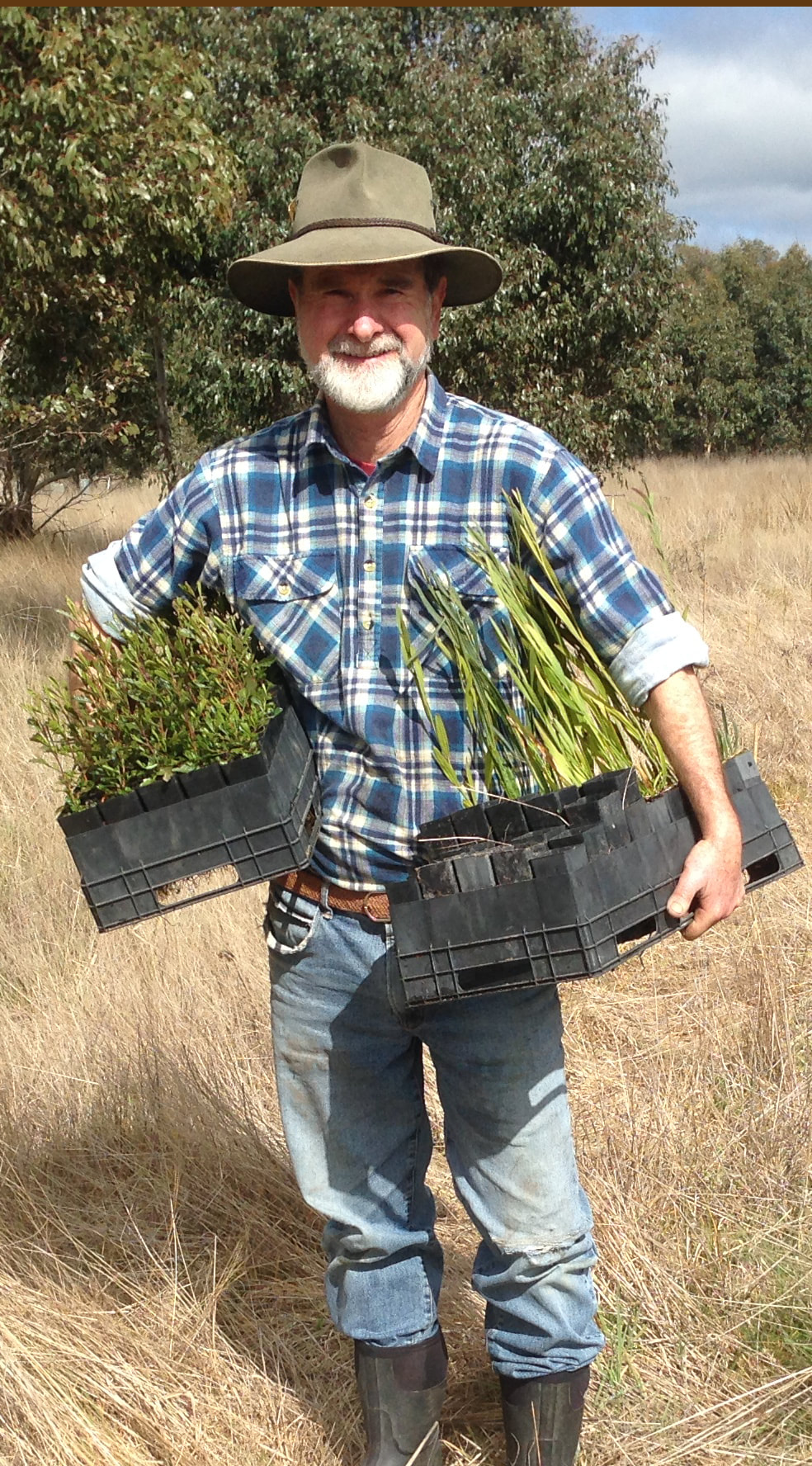

 RSS Feed
RSS Feed
